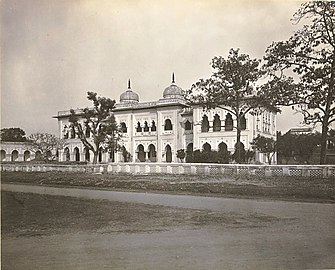Bengal Presidency
It has been suggested that this article should be split into a new article titled Bengal Province. (discuss) (April 2024) |
This article needs additional citations for verification. (September 2022) |
| 1699–1947 | |||||||||||||||||||||||||||||||||||||||||||||||||
Sir Frederick Burrows | |||||||||||||||||||||||||||||||||||||||||||||||||
H. S. Suhrawardy | |||||||||||||||||||||||||||||||||||||||||||||||||
| Legislature | Legislature of Bengal | ||||||||||||||||||||||||||||||||||||||||||||||||
• Division of Bengal during the Partition of India | 1947 | ||||||||||||||||||||||||||||||||||||||||||||||||
| Population | |||||||||||||||||||||||||||||||||||||||||||||||||
• 1770 | 30,000,000[4] | ||||||||||||||||||||||||||||||||||||||||||||||||
| Currency | Indian rupee, Pound sterling, Straits dollar | ||||||||||||||||||||||||||||||||||||||||||||||||
| |||||||||||||||||||||||||||||||||||||||||||||||||
| History of India |
|---|
 |
| Timeline |
| History of Bangladesh |
|---|
 |
|
|
|
| Part of a series on |
| Bengalis |
|---|
 |
The Bengal Presidency, officially the Presidency of Fort William in Bengal and later Bengal Province, was a
The Bengal Presidency emerged from trading posts established in the
In 1836, the upper territories of the Bengal Presidency were organised into the Agra Division or North-Western Provinces and administered by a lieutenant-governor within the Presidency. The lower territories were organised into the Bengal Division and put in charge of lieutenant-governor as well in 1853. The office of the governor of the Presidency was abolished and the Presidency existed as only a nominal entity under the dual government of the two lieutenant-governors at
At its territorial height in the mid nineteenth century, the Bengal Presidency extended from the
In 1862, the
History
Background

In 1599, a
In 1608,
The Mughal court in Delhi was weakened by
In June 1756 the company's factories at Cossimbazar[23] and Calcutta were besieged and captured by the forces of the Nawab of Bengal, with the company's goods, treasure and weapons seized.[24][unreliable source?] Calcutta being renamed Alinagar in honour of the Siraj ud-Daulah's predecessor. A Company force, led by Watson and Robert Clive, recaptured Fort William in January 1757, with the Nawab, Siraj ud-Daulah, agreeing the Treaty of Alinagar, reestablishing the company's right to trade in Bengal, and fortify Fort William. In parallel Robert Clive conspired with Jagat Seth, Omichand and Mir Jafar to install the latter on the musnud of Bengal, a plan that they would implement in June 1757.[25]
The East India Company's victories at the
Administrative changes and the Permanent Settlement
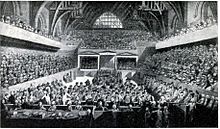
Under
The Cornwallis Code, while defining the rights of the proprietors, failed to give adequate recognition to the rights of the under-tenants and the cultivators. This remained a serious problem for the duration of British Rule, as throughout the Bengal Presidency ryots (peasants) found themselves oppressed by rack-renting landlords, who knew that every rupee they could squeeze from their tenants over and above the fixed revenue demanded from the Government represented pure profit. Furthermore, the Permanent Settlement took no account of inflation, meaning that the value of the revenue to Government declined year by year, whilst the heavy burden on the peasantry grew no less. This was compounded in the early 19th century by compulsory schemes for the cultivation of opium and indigo, the former by the state, and the latter by British planters. Peasants were forced to grow a certain area of these crops, which were then purchased at below market rates for export. This added greatly to rural poverty.
Government of India Acts of 1833 and 1853
In 1833, the British Parliament enacted the
Straits Settlements

In 1830, the British Straits Settlements on the coast of the
Under the administration of the East India Company, the Settlements were used as
Victorian Era
In 1859, under the terms of the Queen's Proclamation issued by Queen Victoria, the Bengal Presidency, along with the rest of British India, came under the direct rule of the British Crown.[33]
1905 Partition of Bengal
The partition of the large province of Bengal, which was decided upon by Lord Curzon, and Cayan Uddin Ahmet, the Chief Secretary of Bengal carried into execution in October 1905. The
The remaining province of Bengal then consisted of the thirty-three districts of
The Indian Councils Act 1909 expanded the legislative councils of Bengal and Eastern Bengal and Assam provinces to include up to 50 nominated and elected members, in addition to three ex officio members from the executive council.[34]
Bengal's legislative council included 22 nominated members, of which not more than 17 could be officials, and two nominated experts. Of the 26 elected members, one was elected by the
The partition of Bengal proved highly controversial, as it resulted in a largely Hindu West Bengal and a largely Muslim East. Serious popular agitation followed the step, partly on the grounds that this was part of a cynical policy of divide and rule, and partly that the Bengali population, the centre of whose interests and prosperity was Calcutta, would now be divided under two governments, instead of being concentrated and numerically dominant under the one, while the bulk would be in the new division. In 1906–1909 the unrest developed to a considerable extent, requiring special attention from the Indian and Home governments, and this led to the decision being reversed in 1911.
Reorganisation of Bengal, 1912

At the Delhi Durbar on 12 December 1911, Emperor George V announced the transfer of the seat of the Government of India from Calcutta to Delhi, the reunification of the five predominantly Bengali-speaking divisions into a unified province of Bengal under a Governor, the creation of a new province of Bihar and Orissa under a lieutenant-governor, and that Assam Province would be reconstituted under a chief commissioner. On 21 March 1912 Thomas Gibson-Carmichael was appointed Governor of Bengal. On 22 March the provinces of Bengal, Bihar and Orissa and Assam were constituted.[36]
The Government of India Act 1919 increased the number of nominated and elected members of the legislative council from 50 to 125, and the franchise was expanded.[37] Bihar and Orissa became separate provinces in 1936. Bengal remained in its 1912 boundaries until Independence in 1947, when it was again partitioned between the dominions of India and Pakistan.
1947 Partition of Bengal
On 8 May 1947, Viceroy
On 20 June 1947, the Bengal Legislative Assembly met to vote on partition plans. At the preliminary joint session, the assembly decided by 126 votes to 90 that if it remained united it should join the new Constituent Assembly of Pakistan. Later, a separate meeting of legislators from West Bengal decided by 58 votes to 21 that the province should be partitioned and that West Bengal should join the existing Constituent Assembly of India. In another separate meeting of legislators from East Bengal, it was decided by 106 votes to 35 that the province should not be partitioned and 107 votes to 34 that East Bengal should join Pakistan in the event of partition.[39] There was no vote held on the proposal for an independent United Bengal.
Government

Initially, Bengal was under the administration of the East India Company, which appointed chief agents/presidents/governors/lieutenant governors in Fort William. The governor of Bengal was concurrently the governor-general of India for many years. The East India Company maintained control with its private armies and administrative machinery. Nevertheless, the East India Company was a quasi-official entity, having received a
Executive councils
Established by
Judiciary

The
Bengal Legislative Council (1862–1947)

The British government began to appoint legislative councils under the
Dyarchy (1920–1937)
British India's
Bengal Legislative Assembly (1935–1947)
The Government of India Act 1935 established the Bengal Legislative Assembly as the lower chamber of the Bengali legislature. It was a 250-seat assembly where most members were elected by either the General Electorate or the Muslim Electorate (under the Communal Award). Other members were nominated. The separate electorate dividing Muslims from the general electorate was deeply controversial. The Prime Minister of Bengal was a member of the assembly.
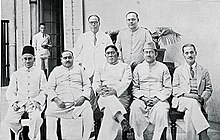
In the
The first Huq cabinet dissolved after the BPML withdrew from his government. Huq then formed a second coalition with the
The Bengal Assembly was divided into the
Civil liberties
Princely states

Himalayan kingdoms
Bengal was strategically important for the Himalayan regions of Nepal,
Foreign relations

The United States of America began sending envoys to Fort William in the 18th century. President
Education

British rule saw the establishment of
Primary education was mandatory under the Compulsory Education Acts.
Each district of Bengal had a
Europeans played an important role in modernizing the Bengali language. The first book on Bengali grammar was compiled by a Portuguese missionary.[52] English was the official language. The use of Persian as an official language was discontinued by Act no. XXIX of 1837 passed by the President of the Council of India in Council on 20 November 1837. However, Persian continued to be taught in some institutions. Several institutions had Sanskrit and Arabic faculties.[53] The following includes a partial list of notable colleges, universities and learned societies in the Bengal Presidency.
- Asiatic Society
- Scottish Church College
- Presidency College
- Fort William College
- Calcutta Civil Engineering College
- City College, Calcutta
- Calcutta Medical College
- University of Calcutta
- Dhaka College
- Dhaka Medical College
- Ahsanullah School of Engineering
- University of Dhaka
- Chittagong College
- Rajshahi College
- Brajalal College
- Carmichael College
- Victoria College
- Bethune College
- Eden College
- Cotton College
- Calcutta School of Tropical Medicine
- Bose Institute
- Serampore College
- Thomason College of Civil Engineering
- Ananda Mohan College
- Visva-Bharati University
- St. Xavier's College
- Indian Association for the Cultivation of Science
- Sanskrit College
- Calcutta Madrasa
- Academy of Fine Arts
- Indian Science Congress Association
- Agri Horticultural Society of India
- Geological Survey of India
- Botanical Survey of India
- Calcutta Mathematical Society
- Archaeological Survey of India
- Anthropological Survey of India
- Rajendra College
Economy


In Bengal, the British inherited from the Mughals the biggest revenue earnings in the Indian subcontinent. For example, the revenue of pre-colonial Dhaka alone was 1 million rupees in the 18th century (a high amount in that era).

The Bengal Presidency had the largest gross domestic product in British India.[57] The first British colonial banks in the Indian subcontinent were founded in Bengal. These included the General Bank of Bengal and Bihar (1733); Bank of Hindostan (1770), Bank of Bengal (1784); and the General Bank of India (1786). Other banks in Bengal included the Bank of Calcutta (1806), Union Bank (1829); Government Savings Bank (1833); The Bank of Mirzapore (c. 1835); Dacca Bank (1846); Kurigram Bank (1887), Kumarkhali Bank (1896), Mahaluxmi Bank, Chittagong (1910), Dinajpur Bank (1914), Comilla Banking Corporation (1914), Bengal Central Bank (1918), and Comilla Union Bank (1922).[58] Loan offices were established in Faridpur (1865), Bogra (1872), Barisal (1873), Mymensingh (1873), Nasirabad (1875), Jessore (1876), Munshiganj (1876), Dacca (1878), Sylhet (1881), Pabna (1882), Kishoreganj (1883), Noakhali (1885), Khulna (1887), Madaripur (1887), Tangail (1887), Nilphamari (1894) and Rangpur (1894).[58]
The earliest records of securities dealings are the loan securities of the
Agricultural products included rice, sugarcane and vegetables. The main cash crops were
The
Tea became a major export of Bengal. Northwestern Bengal became the center of Darjeeling tea cultivation in the foothills of the Himalayas. Darjeeling tea became one of the most reputed tea varieties in the world. The Darjeeling Himalayan Railway was constructed in the tea plantation zone.[67] In eastern Bengal, the Sylhet and Chittagong hilly regions became hubs of tea production. Assam tea was produced in the northeastern part of the Bengal Presidency.
Aside from the British, the chief beneficiaries of the colonial economy were the Zamindars (landed gentry). The Permanent Settlement enforced a system in which peasants were indebted to the Zamindars. The peasants rented land from the Zamindars and became tenant farmers. Strong control of land by the Zamindars meant the British had few headaches in exploiting trade and business. However, Bengal received little attention for industrialization due to the entrenched peasant-zamindar relationship under the Permanent Settlement.[68] The Zamindars of Bengal built mansions, lodges, modern bungalows, townhouses, and palaces on their estates. Some of the largest mansions include the Hazarduari Palace in Murshidabad, the Ahsan Manzil on the Nawab of Dhaka's estate, the Marble Palace in Calcutta, and the Cooch Behar Palace.
Infrastructure and transport
Railways

After the invention of railways in Britain, British India became the first region in Asia to have a railway. The
The
Roads and highways
In the 1830s the East India Company began to rebuild the ancient Grand Trunk Road into a paved highway. The company required the road for commercial and administrative purposes. It linked Calcutta to Peshawar in the North-West Frontier Province. For the project, the company founded a college to train and employ local surveyors, engineers, and overseers.[72][73] In the east, the road extended to Sonargaon, Comilla and Chittagong. After the first partition of Bengal in 1905, newly built highways connected the inaccessible areas of Assam and the Chittagong Hill Tracts. All district towns were connected by an inter-district road network.[74]
Waterways

A ghat in Bengal refers to a
.After the first partition of Bengal in 1905, a number of new ferry services were introduced connecting Chittagong, Dhaka, Bogra, Dinajpur, Rangpur, Jalpaiguri, Maldah and Rajshahi. This improved communication network boosted trade and commerce.[74]
Aviation
An early attempt at manned flight in Bengal was by a young female
An airfield opened next to a
The following includes a partial list of airports and airfields established during British rule in Bengal. Airfields were used by Allied Forces during World War II.
- Calcutta Airport
- Tejgaon Airfield
- Chittagong Airfield
- Sylhet Airport
- Dohazari Airfield
- Shamshernagar Airport
- Lalmonirhat Airport
- Thakurgaon Airport
- Saidpur Airport
- Bogra Airport
- Ishwardi Airport
- Comilla Airport
- Fenny Airfield
- Hathazari Airfield
- Asansol Airfield
- Chakulia Airfield
- Piardoba Airfield
- Guskhara Airfield
- Dudhkundi Airfield
- Pandaveswar Airfield
- Charra Airfield
Military

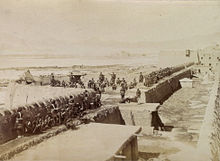
The
Major military engagements affecting British Bengal included the
Famines and other natural disasters

Colonial India as well as the Bengal Presidency suffered from the
With various instances of extortion and other deeds of maladministration ... With impoverishing and depopulating the whole country ... with a wanton and unjust, and pernicious, exercise of his powers ... in overturning the ancient establishments of the country ... With cruelties unheard of and devastations almost without name ... Crimes which have their rise in the wicked dispositions of men – in avarice, rapacity, pride, cruelty, malignity, haughtiness, insolence, ferocity, treachery, cruelty, malignity of temper – in short, nothing that does not argue a total extinction of all moral principle, that does not manifest an inveterate blackness of heart, a heart blackened to the very blackest, a heart corrupted, gangrened to the core ... We have brought before you the head [Hastings] ... one in whom all the frauds, all the peculations, all the violence, all the tyranny in India are embodied.
In 1876, about 200,000 Bengalis were killed in Barisal as a result of the 1876 Bengal cyclone.[90]
The Bengal Presidency endured a vast famine between
Culture
Literary development

The English language replaced Persian as the official language of administration. The use of Persian was prohibited by Act no. XXIX of 1837 passed by the President of the Council of India in Council on 20 November 1837,[53][96] bringing an end to six centuries of Indo-Persian culture in Bengal. The Bengali language received increased attention. European missionaries produced the first modern books on Bengali grammar. In pre-colonial times, Hindus and Muslims would be highly attached to their liturgical languages, including Sanskrit and Arabic. Under British rule, the use of Bengali widened and it was strengthened as the lingua franca of the native population. Novels began to be written in Bengali. The literary polymath Rabindranath Tagore was awarded the Nobel Prize in Literature in 1913. The cultural activist Kazi Nazrul Islam gained popularity as British India's Rebel Poet. Jagadish Chandra Bose pioneered Bengali science fiction. Begum Rokeya, author of Sultana's Dream, became an early feminist science fiction author.
Media

Numerous newspapers were published in British Bengal since the 18th century. Many were in English.
Visual arts
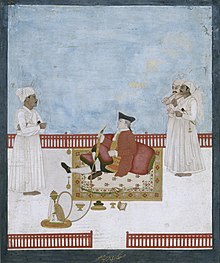
The Company School of Painting in Calcutta, Murshidabad, and Patna saw Mughal miniatures absorb images of British colonial officials in place of Mughal officials.
Calcutta Time
Calcutta Time was the time zone of the Bengal Presidency. It was established in 1884. It was one of the two time zones of British India. In the latter part of the 19th century, Calcutta Time was the most prevalent time used in the Indian part of the British Empire with records of astronomical and geological events recorded in it.[100][101]
Cinema
The
The
In 1927–28, the
Sports

Bengal renaissance
The Bengal renaissance refers to social reform movements during the 19th and early 20th centuries in the region of Bengal in
Bengal played a major role in the
Architecture
Civic architecture began following European styles after the advent of the East India Company's authority. The
- Architecture in British Bengal
-
Howrah Bridge in 1945
-
Writer's Building
-
Hardinge Bridge, 1915
-
Dacca College, 1904
-
Dacca Madrasa, 1904
-
Nawab's Shahbagh Garden, 1904
Society
Bengali society remained deeply conservative during the colonial period with the exception of social reform movements. Historians have argued that the British used a policy of divide and rule among Hindus and Muslims. This meant favoring Hindus over Muslims and vice versa in certain sectors. For example, after the Permanent Settlement, Hindu merchants such as the Tagore family were awarded large land grants that previously belonged to the Mughal aristocracy. In Calcutta, where Hindus formed a majority, wealthy Muslims were often given favors over Hindus. One aspect that benefitted the Hindu community was increased literacy rates. Many Muslims, however, remained alienated from English education after the abolition of Persian. Bengali society continued to experience religious nationalism which led to the partition of Bengal in 1947.[citation needed]
British Bengali cities included a cosmopolitan population, including Armenians and Jews.
See also
- List of governors of Bengal Presidency
- Advocate-General of Bengal
- Bombay Presidency
- Madras Presidency
References
- ^ Government of India Act 1833 (38). Parliament of the United Kingdom of Great Britain and Ireland. 28 August 1833.
- ^ Government of India Act 1935 (PDF) (269—2). Parliament of the United Kingdom of Great Britain and Northern Ireland. 2 August 1935. p. 166.
- ^ "Battle of Plassey | National Army Museum". Nam.ac.uk.
- ^ Visaria, Leela; Visaria, Praveen (1983), "Population (1757–1947)", in Dharma Kumar (ed.), The Cambridge Economic History of India: Volume 2, C.1757-c.1970. Appendix Table 5.2.
- ^ "Economic History of Bengal Presidency" (PDF). International Growth Centre.
- ^ The Bengalis. p. 143.
- S2CID 248603349.
- ISBN 9780521002547.
- ISBN 978-1-80526-026-4. Retrieved 3 August 2023.
- ^ Tan Tai Yong. "A Tale of Two Cities: Singapore and Kolkata Past and Present" (PDF). National University of Singapore. p. 3.
- ^ a b "The Commonwealth and Dhaka". 15 September 2023.
- ^ a b "The Straits Settlements becomes a residency - Singapore History". Eresources.nlb.gov.sg. Retrieved 30 March 2020.
- ^ "English Releases".
- ^ "Bengal Legislative Council". Banglapedia.
- ^ "Before the East India Company". 27 September 2019.
- ^ "East India Company".
- ISBN 978-1-63557-395-4.
- ^ Imperial Gazetteer of India vol. II 1909, pp. 452–472
- ^ Daniyal, Shoaib (21 December 2015). "Forgotten Indian history: The brutal Maratha invasions of Bengal". Scroll.in. Retrieved 18 February 2022.
- ^ "Relation of Alivardi with the Marathas". History Discussion - Discuss Anything About History. 31 August 2015. Retrieved 18 February 2022.
- ^ OUM. pp. 16, 17
- ISBN 978-1-932705-54-6.
- ^ Hill, Samuel Charles (1905). Bengal in 1756-57, a selection of public and private papers dealing with the affairs of the British in Bengal during the reign of Siraj-Uddaula; with notes and an historical introduction. Robarts - University of Toronto. London, Murray.
- ^ Ghosh, Deepanjan (11 November 2017). "The Siege of Calcutta". livehistoryindia.com. Retrieved 18 February 2022.
- JSTOR 44303890.
- ^ Imperial Gazetteer of India vol. II 1909, pp. 473–487
- ^ Imperial Gazetteer of India vol. II 1909, pp. 488–514
- ^ Chesney, George. Indian Polity: A View of the System of Administration in India.
- ^ Anderson, C (2007) The Indian Uprising of 1857–8: prisons, prisoners, and rebellion, Anthem Press. P14
- ^ S. Nicholas and P. R. Shergold, "Transportation as Global Migration", in S. Nicholas (ed.) (1988) Convict Workers: Reinterpreting Australia's Past, Cambridge: Cambridge University Press, Cambridge
- JSTOR 41492016.
- ^ Petition reprinted in The Straits Times, 13 October 1857
- ISBN 0-00-638843-4.
- ^ Ilbert, Sir Courtenay Peregrine (1907). "Appendix II: Constitution of the Legislative Councils under the Regulations of November 1909", in The Government of India. Clarendon Press. pp. 431.
- ^ Ilbert, Sir Courtenay Peregrine (1907). "Appendix II: Constitution of the Legislative Councils under the Regulations of November 1909", in The Government of India. Clarendon Press. pp. 432–5.
- ^ Ilbert, Sir Courtenay Peregrine (1922). The Government of India, Third Edition, revised and updated. Clarendon Press. pp. 117–118.
- ^ Ilbert, Sir Courtenay Peregrine (1922). The Government of India, Third Edition, revised and updated. Clarendon Press. p. 129.
- ^ Shoaib Daniyal (6 January 2019). "Why did British prime minister Attlee think Bengal was going to be an independent country in 1947?". Scroll.in. Retrieved 30 March 2020.
- ISBN 978-0-521-30448-1.
- ISBN 978-0-521-47862-5.
- ^ "Separation of the Judiciary". Banglapedia. Retrieved 30 March 2020.
- ^ The Working Of Dyarchy In India 1919 1928. D.B.Taraporevala Sons and Company. 1928.
- ISBN 978-0-521-45850-4.
- ISBN 9789848171004.
- ^ a b "Huq, AK Fazlul". En.banglapedia.org.
- ^ Syed Ashraf Ali. "Sher-e-Bangla: A natural leader". The Daily Star. Retrieved 10 August 2017.
- ^ Nalanda Year-book & Who's who in India. 1946.
- S2CID 157075881.
- ^ "U.S. Consulate General Kolkata". In.embassy.gov.
- ^ "Education". Banglapedia. Retrieved 30 March 2020.
- ^ Rahman, Md Zillur (2012). "Library". In Islam, Sirajul; Jamal, Ahmed A. (eds.). Banglapedia: National Encyclopedia of Bangladesh (Second ed.). Asiatic Society of Bangladesh.
- ^ "Você fala Bangla?". Dhaka Tribune. 24 January 2014. Retrieved 3 July 2020.
- ^ a b "Persian". Banglapedia. 15 February 2015. Retrieved 30 March 2020.
- ISBN 978-984-05-1374-1.
- ISBN 0-02-866070-6. Retrieved 3 August 2017.
- ISBN 978-1-136-82552-1.
- ^ "Reimagining the Colonial Bengal Presidency Template (Part I)". Daily Sun. Archived from the original on 2 February 2021. Retrieved 30 March 2020.
- ^ a b "Banking System, Modern". Banglapedia. Retrieved 30 March 2020.
- ^ "Lights on at Lyons Range - Bombay bourse boost for city exchange". The Telegraph. Kolkata. 30 October 2017. Retrieved 30 March 2020.
- ^ a b "Narayanganj". Banglapedia. Retrieved 25 July 2017.
- ISBN 978-0-85115-935-5.
- ^ Willis's Current notes. London: G. Willis. 1886. p. 16.
- ^ Tauheed, Q S (1 July 2005). "Forum for planned Chittagong's search for its conservation -I". The Daily Star. Dhaka. Archived from the original on 22 January 2015. Retrieved 22 January 2015.
- ^ "Chittagong Port Authority". Banglapedia. Retrieved 24 July 2017.
- ^ "The Bay of Bengal: Rise and Decline of a South Asian Region". 16 June 2014. Archived from the original on 12 December 2021. Retrieved 24 July 2017 – via YouTube.
- ^ "Chapter 1 : Introduction : Chambers of Commerce" (PDF). Mccibd.org. Retrieved 1 March 2022.
- ISBN 978-81-7268-018-3.
- S2CID 15466381.
- ^ Huddleston, George (1906). History of the East Indian Railway. Calcutta: Thacker, Spink & Company.
- ISBN 81-7102-003-8.
- ^ "Railway". Banglapedia. Retrieved 30 March 2020.
- ISBN 9780313097362. Retrieved 15 May 2018.
- ISBN 9788131753750.
- ^ a b "Eastern Bengal and Assam". Banglapedia. 5 May 2014. Retrieved 30 March 2020.
- ISBN 978-0-8263-6282-7, archived from the originalon 14 August 2022, retrieved 22 November 2021
- ^ "Air Routes in India". FlightGlobal. 15 April 1920. Retrieved 18 September 2011.
- ^ "Bengal Flying Club Opened". FlightGlobal. 7 March 1929. Retrieved 18 September 2011.
- ^ "State of Air Transport in the British Empire". FlightGlobal. 29 August 1930. Retrieved 18 September 2011.
- ^ "Global Networks Before Globalisation: Imperial Airways and the Development of Long-Haul Air Route". Globalization and World Cities Research Network. 5 December 2007. Retrieved 18 September 2011.
- ^ "1930 Histoire d'Air Orient". Retrieved 18 September 2011.
- ^ "Amsterdam- Batavia Flight". FlightGlobal. 20 November 1924. Retrieved 18 September 2011.
- ^ "気になる薄毛の事". nscbiairport.org. Archived from the original on 19 May 2015. Retrieved 9 May 2015.
- ^ "Amelia Earhart's Circumnavigation Attempt". Tripline.net. Retrieved 18 September 2011.
- ISBN 978-1576079256.
- ISBN 0-333-41837-9.
- ^ Defence Journal:Volumes 4-5. 2001. p. 66.
- ISBN 9788170623311.
- ^ Calcutta Review 1956. University of Calcutta. 1956. p. 38.
- ISBN 978-1-63557-395-4.
- ^ SMRC-No.1 – The impact of tropical cyclones on the coastal regions of SAARC countries and their influence in the region, SAARC Meteorological Research Center (SMRC),1998.
- ^ a b Safi, Michael (29 March 2019). "Churchill's policies contributed to 1943 Bengal famine – study". The Guardian.
- ^ Oppenheim, Maya (8 September 2017). "Winston Churchill has as much blood on his hands as the worst genocidal dictators, claims Indian politician". The Independent.
- ^ Oppenheim, Maya (21 March 2017). "'Winston Churchill is no better than Adolf Hitler,' says Indian politician Dr Shashi Tharoor". The Independent. Retrieved 30 March 2020.
- ^ "The Bengali Famine - The International Churchill Society". Winstonchurchill.org. 18 November 2008. Retrieved 30 March 2020.
- ISBN 978-1-101-56131-7.
- ISBN 0-313-29366-X.
- ^ "Newspapers and Periodicals". Banglapedia. Retrieved 30 March 2020.
- ^ "Radio". Banglapedia. Retrieved 30 March 2020.
- ^ Nanak Ganguly (June 2012). "Company School Paintings of Calcutta, Murshidabad, Patna (1750-1850): Doctoral Thesis of Late Dipak Bhattacharya (1960-2007)". Art etc. News & Views. Archived from the original on 5 September 2015.
{{cite magazine}}: CS1 maint: unfit URL (link) - ^ Richard Dixon Oldham (1899). Report of the Great Earthquake of 12th June, 1897. Office of the Geological survey. p. 20.
- ^ The Asiatic Journal and Monthly Register for British and Foreign India, China, and Australia. Parbury, Allen, and Co. 1834. p. 1.
- ^ "Who's Who of Victorian Cinema - Hiralal Sen". victorian-cinema.net.
- ^ "The Liberation Struggles of a Country and a Festival". dhakafilmfestival.org. Dhaka Film Festival. Archived from the original on 11 January 2014. Retrieved 1 December 2014.
- ISBN 978-0-415-46544-1.
- ^ "Dhaka Nawab Family and Film". nawabbari.com. Nawab Bari. Archived from the original on 7 March 2021. Retrieved 1 December 2014.
- ^ "Did you know? First Pakistani silent movie makes it to international film fests". The Express Tribune. Retrieved 1 December 2014.
- ^ "Ramna Racecourse". En.banglapedia.org.
- ISBN 978-0-8223-9247-7.
- ISBN 978-81-7476-355-6.
The Bengal Renaissance can be said to have started with Raja Ram Mohan Roy (1775-1833) and ended with Rabindranath Tagore (1861-1941).
- JSTOR 2168519.
Works cited
This article incorporates text from a publication now in the public domain: Chisholm, Hugh, ed. (1911). "Bengal". Encyclopædia Britannica (11th ed.). Cambridge University Press.
- Mandal, Mahitosh (2022). "Dalit Resistance during the Bengal Renaissance: Five Anti-Caste Thinkers from Colonial Bengal, India". Caste: A Global Journal on Social Exclusion. 3 (1): 11–30. S2CID 249027627.
- C. A. Bayly Indian Society and the Making of the British Empire (Cambridge) 1988
- C. E. Buckland Bengal under the Lieutenant-Governors (London) 1901
- Sir James Bourdillon, The Partition of Bengal (London: Society of Arts) 1905
- Susil Chaudhury From Prosperity to Decline. Eighteenth Century Bengal (Delhi) 1995
- Sir William Wilson Hunter, Annals of Rural Bengal (London) 1868, and Odisha (London) 1872
- Imperial Gazetteer of India. Vol. 2. Oxford: Clarendon Press. 1909.
- Ray, Indrajit Bengal Industries and the British Industrial Revolution (1757–1857) (Routledge) 2011
- John R. McLane Land and Local Kingship in eighteenth-century Bengal (Cambridge) 1993









